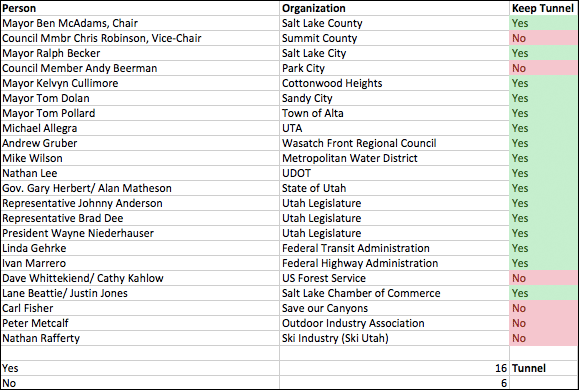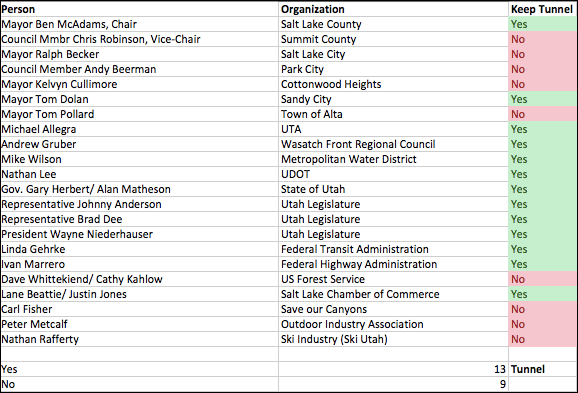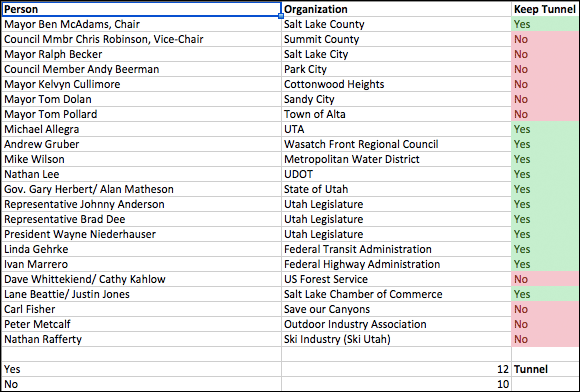First Autonomous Truck Hits the Road in Nevada… Why Not Here?
You may know that I think we are missing a huge opportunity here in Summit County to embrace the autonomous vehicle. I don’t mean just waiting for them to become available and then passing some laws. I believe we have unique characteristics and needs that would support getting tech companies and vehicle manufactures to test their vehicles in and around Summit County.
As we stand by, the opportunity is moving past us. Case in point is the first autonomous semi to hit the open roads in Nevada. It had a public showing last night and has run 10,000 miles in testing. It is the real deal and it is likely to be in production soon. In this case, the truck has a driver but the vehicle does most of the work and only needs assistance in some cases.
Yet, there is still an opportunity for a place like Summit County. Dr. Wolfgang Bernhard, Daimler AG’s truck boss says they are moving forward fast but there are still obstacles. “Obviously there’s some more testing we have to do,” Bernhard said. “We have to see how this thing performs in the rain, the sun, cold days, or at subzero.” That’s something that Daimler will have to wait for, as other states could be slow to adapt the same self-driving-friendly regulation that Nevada already has.
And there-in lies the opportunity. Utah has an opportunity to be at the forefront of this technology. Summit County has an opportunity to help build this industry. I wish it was a concept that we could lead on. But that just doesn’t seem to be our style.
Can You Come Up With a Scenario Where a Mountain Accord Tunnel Would Be Stopped, if the State Really Wanted It?
In a previous article, I outlined that it only takes a simple majority of the Mountain Accord Executive Board to achieve a consensus vote for action. I thought it may be fun to run through some scenarios on how different people may vote on something like a tunnel from Brighton to PCMR (if the tunnel continues to be part of the Accord after public comments).
Of course this is all just guessing (and a little bit of fun). I have no idea how someone would really vote, but hopefully this will demonstrate what it would take to shut down a tunnel. If you are one of these people and I have your vote pegged wrong, let me know.
My Most Likely Scenario: Andy Beerman and Chris Robinson listen to their constituents. Environmental folks and US Forest vote against plan with a tunnel (with exception of water dept). All State and Federal vote for it. Towns at base of Cottonwood Canyons vote for it. Alta Mayor votes for it because he has stated that it is likely transportation is going to be coming through Alta so they need to prepare for it.
Outcome: Near Consensus… Tunnel is included
Ski Industry Defection Just like above but Vail decides that it doesn’t want tunnel. They push Nathan Rafferty to oppose the tunnel. Outdoor industry follows.
Outcome: Near Consensus… Tunnel is included
Half of Cities Say No: Just like above but half the cities, like Salt Lake, Cottonwood Heights, and Alta decide a tunnel isn’t good.
Outcome: Majority… Tunnel is included
All Cities and Counties Say No: Just like above but all the cities and counties decide there should be no tunnel. That’s not likely but that’s not even enough to stop a tunnel.
Outcome: Majority… Tunnel is included
Effectively in order to prevent something like a tunnel, if it came to a vote of the executive board, is that our local politicians would need to be against it, all environmental groups would need to be against it, half the cities/counties in the Wasatch Front would need to be against it, and then we’d need someone from the state or federal government (legislature, UDOT, UTA, etc.) to stick a fork in it.
Maybe you have better info and can come up with a scenario where a tunnel wouldn’t pass. However, given that a consensus is really a simple majority, it’s hard for me to come up with a way a tunnel between Brighton and PCMR could be prevented if the powers that be really wanted it.
Let me know where I’m wrong.
Note: I also did not take into account the new GOED representative on the board, because they also wanted to add an “environmental” person to balance it. However, I don’t know who that is or if they’ve been added. So, I added neither.
Here’s the spreadsheet if you want to play along at home.
I Owe Someone a Steak Dinner Regarding Mountain Accord
Last week I received a tip from a reader regarding the story on What is Consensus Decision Making. I said I would buy someone a steak dinner if they knew what consensus decision making meant with the Mountain Accord. In true Park Rag function, someone provided the Mountain Accord Charter almost immediately.
That said, I don’t think they necessarily disagreed with the point of the article which was “when they say consensus, it probably doesn’t mean what you think it means.” This is important because what Mountain Accord asks us to do is put our faith in consensus. Our leaders tell us that there are “Exit Ramps” but the problem is that as long as Mountain Accord exists in its current form, we are subject to the decisions of a few people.
So, according to the Mountain Accord Charter, here is the decision making process:
- The Executive Board approves administrative decisions by a simple majority.
- There are then milestone approvals. The document says, “Each milestone builds on the approval of the previous milestone, culminating in a final decision on a preferred scenario at the end of Phase I. Executive Board members agree not to re-visit milestone decisions…”
- “The Executive Board will make substantive (non-administrative) decisions, including approvals at milestones, through a consensus-based process.”
Then let’s dive a little deeper into the defined consensus based decision process. I’ll cut and paste the highlights from the charter:
“A consensus-based process builds trust, encourages sharing of information, and provides an environment for collaborative problem solving. Consensus does not mean that everyone will be equally satisfied with the decision; rather, it means that the best decision was made given the agreed-upon process, stakeholders, and timeframe.”
On each issue, Executive Board members may indicate the “following levels of support”:
- Concurrence
- Concurrence with minor point of contention
- Consent to move forward with but disagree with outcome
- Waiver
- Dissent
- Indecision until more information is provided
The charter continues, “Consensus is not reached if any Board members indicate indecision or dissent.” If there is any dissent or indecision, a consensus is not reached. So, what happens then? The program manager (Laynee Jones) can perform some procedural actions (like have them write down why they dissented). Then the program manager can have the executive board perform an administrative vote, which requires a simple majority.
So, who is on that Executive board (as of the charter formation):
| Person | Organization |
| Mayor Ben McAdams, Chair | Salt Lake County |
| Council Mmbr Chris Robinson, Vice-Chair | Summit County |
| Mayor Ralph Becker | Salt Lake City |
| Council Member Andy Beerman | Park City |
| Council Member Steve Capson | Wasatch County |
| Mayor Kelvyn Cullimore | Cottonwood Heights |
| Mayor Tom Dolan | Sandy City |
| Mayor Tom Pollard | Town of Alta |
| Michael Allegra | UTA |
| Andrew Gruber | Wasatch Front Regional Council |
| Mike Wilson | Metropolitan Water District |
| Nathan Lee | UDOT |
| Gov. Gary Herbert/ Alan Matheson | State of Utah |
| Representative Johnny Anderson | Utah Legislature |
| Representative Brad Dee | Utah Legislature |
| President Wayne Niederhauser | Utah Legislature |
| Linda Gehrke | Federal Transit Administration |
| Ivan Marrero | Federal Highway Administration |
| Dave Whittekiend/ Cathy Kahlow | US Forest Service |
| Lane Beattie/ Justin Jones | Salt Lake Chamber of Commerce |
| Carl Fisher | Save our Canyons |
| Peter Metcalf | Outdoor Industry Association |
| Nathan Rafferty | Ski Industry (Ski Utah) |
So for any option, you really need half of the board to vote yes. If you get 66% of the board to vote for something then you have what George Orwell Mountain Accord calls “Newspeak” “A Near Consensus Decision.”
There you have it. Thanks to an anonymous tipster I now understand the decision process. That said, I wouldn’t say I feel better. Do you think getting half of the above people to make a decision unliked by Summit County residents would be hard?
I’ll save my opinion for the next post.
h/t to the anonymous person who provided this info.
Summit County is One of the Best Counties in the Country for Income Mobility for Poor Children
We all know Summit County is a great place to grow up. We have great outdoor activities. We have good schools. It also appears that Summit County is among the best counties in the U.S. in helping poor children move up the income ladder… in fact it is does better than 98% of counties in America according to a recent Harvard study. A child spending 20 years growing up in Summit County will make about $6,000 more annual household income at age 26 than if they grew up in an average place. Duchesne County is even better at $8,100 added to annual income.
The researchers found five factors associated with upward mobility: less segregation by income and race, lower levels of income inequality, better schools, lower rates of violent crime, and a larger share of two-parent households.
Of course, here at the Park Rag, we never like to paint too rosy of a picture. That gives us nothing to work for. So, what’s the bad news that may end up impacting you? For rich kids in Summit County, on average they will earn $130 less per year than average because they grew up here (that equates to 73% of counties being better than us). For the ultra-rich, they make $3,000 less (96% of counties are better).
But I’m not going to weep the 1%-ers. They’ll just have to grow up in Malibu instead. It’s interesting to wonder why though.
Here is the New York Times article which allows you to check different counties.
Best Email of the Day… And a bear update
I love when we get reader email. One this morning was very snarky funny. It reads:
“Hey Park Rag. With that bear destroying Jeremy Ranch, perhaps the City Council should have taken that trip to the Bear Sanctuary in Whistler after all. Yours Truly”
I will point out that if you are on the City Council, you just can’t win.
And for all you bear lovers, a reader sent in a picture of the bear.
Some people call it a brown bear… but I’ll call it a Grizzly Bear. That way when the Park Record reports on it on Wednesday, they can have a title like:
Grizzly Gobbles Garbage in Jeremy Ranch
Update: I was looking up grizzly bears and found that the brown bear (or grizzly bear) was last seen in Utah in the 1920’s. So, black bears must be pretty brown when young or this black bear is a species that’s pretty brown (i.e. a cinnamon bear). However, I’ll keep calling it a grizzly. It sounds scarier. As Mark Twain said, “Never let the truth get in the way of a good story.”
You May Want to Sign up for the Summit County Sheriff’s Code Red System
How do you get notified of important information regarding our community? Some people use Twitter or Facebook. Others may happen to catch information on KPCW. Can I suggest perhaps an additional way, especially for life threatening emergencies?
This morning I received a call from the Summit County Sheriff’s automated Code Red system. It warned me that a bear was sighted by Sheriff’s deputies in my neighborhood. While this bear was only attacking trash cans, it could have been dangerous for my dogs. Yet, I can think of many other scenarios where information from law enforcement could mean the difference between life and death. Imagine a forest fire headed toward your house or what to do in the aftermath of an earthquake. It just makes sense to have a channel of communications ready to go between citizens and those people who have the information to help us.
I’ve been signed up on the service for quite a while and this is the first call I’ve received, so it’s not like it will spam you.
To sign up, you go here:
It costs nothing and could be a decision that saves your family’s life some day.
Update on the Hidden Cove Bear
On Sunday, the Summit County Sheriff’s office confirmed that they had spotted the bear that has been reported in Hidden Cove and South Ridge. They reported that they have contacted the Utah Division of Wildlife Services (DWS) and the DWS will be out on today looking to find the bear so it can relocated.
It seems the young bear is going after garbage cans, so until they are able to capture it, you’ll want to take precautions around your home.
Bear Spotted in Hidden Cove
We’ve heard a report of a bear being spotted in Hidden Cove yesterday. The owners of their home heard some thrashing in the bushes and thought it was likely a moose, but upon further investigation it turned out to be a young bear.
Previously, we’ve heard reports of bears in old town and south of interstate 80, but this is the first report of a bear on the north side that we’ve heard in quite a while. So, if you have animals or young children, and live on the north side of interstate 80, you may want to be a little more cautious.
Park City School District Is The 30th Highest Paying School District in the Country for First Year Teachers
It’s an interesting time for schools and teachers in the Park City School District. The School Board appears hell-bent on going on a building binge. Listening to school district officials on KPCW this week talking about the additional buildings the district wants, it sounds like a kid on Christmas Eve who almost can’t wait for Santa to deliver a new XBOX, a scooter, a doll house, a bike, a laptop, an iPad, an iPhone, and maybe even an Apple Watch.
The problem is that money doesn’t grow on trees and at some point people will say, “we already have one of the best school districts in the state…how do students benefit from spending millions more.” This may not impact those buildings but could likely impact teacher salaries.
It turns out that Park City’s starting teacher salaries are among the top 50 highest salaries in the country. According to Top Masters in Education, Park City’s is the 30th highest paying school district IN THE COUNTRY for first year teachers. That would put us in the top 0.2% of all school districts in the country.
So when people’s taxes go up $100 per year to build new schools and then a year later they are asked for more tax dollars to increase teacher salaries, what is the likely response? We wouldn’t be surprised to hear from the public that “Park City teachers are already in the top 1% of all teachers, our schools are already pretty good, and we just gave. So, no thanks.”
In my mind it comes down to deciding whether to spend money on buildings or teachers. If that’s the choice, I’ll always bet on the teacher.
PSA: Your Mac and Website Security
While one of my passions is local government (which is why I love doing the Park Rag), my “day job” is in the computer industry. This week we had a security auditor come in and review my company’s security. The auditor was good … and intense. He had just finished 4 years in Kuwait working on bases, securing the military computer infrastructure.
Out of that security review, two things came to light that I wasn’t aware of that I think may help others in Park City. The first is around our computers. I use a Mac, and as I sit in coffee shops and attend government meetings, I see a lot of other people do too. I had never bothered getting antivirus/firewall software for my mac. I thought that was something for “those Windows folks” to be concerned with. The auditor was able to hack my Mac in about 5 minutes. He said that about 5 years ago it was true that Mac users didn’t need to worry about security but that time has passed.
So, if you use a Mac and don’t have your firewall turned on and don’t have virus software installed, I would recommend you do both. In my research, a company called Sophos seems to have a good antivirus package for Macs that is free. In addition to virus scanning you will also want to turn on your firewall. To turn your firewall on, click on the apple in the upper left of your screen, click System Preferences, click the Security Icon, select the Firewall tab, and enable it (you may need to click the lock in the lower left hand corner to be able to turn it on). What the firewall does is block incoming connections to your computer (unless you specifically OK them).
The second issue is around a popular piece of software that makes it easy to run a website. That software is called WordPress. It’s what we run here at the Park Rag. The problem is that there is currently a huge hole in WordPress that let’s someone take over your website. If you have comments enabled on your site, a malicious person can send through characters that allow them to take over your website. This vulnerability exists in the most recent versions of WordPress.
While you may not think this sort of thing applies to you, last month the Running With ED WordPress site was hacked and pointed people to a Viagra site. So, your website may be running WordPress and not even know it. You can use this website to check if your site is on WordPress. If it is, you will want to check with your tech folks to make sure that your site isn’t at risk.
If you have questions, feel free to email me or leave your questions in the comments. I’m happy to help.






